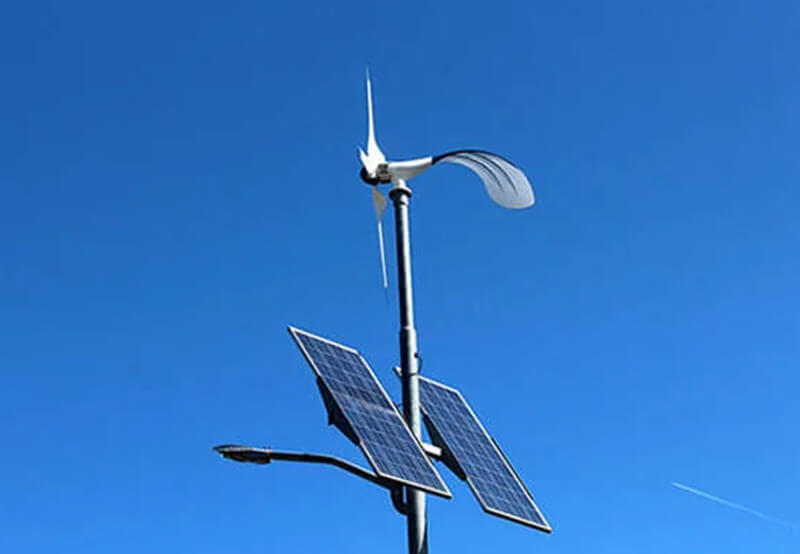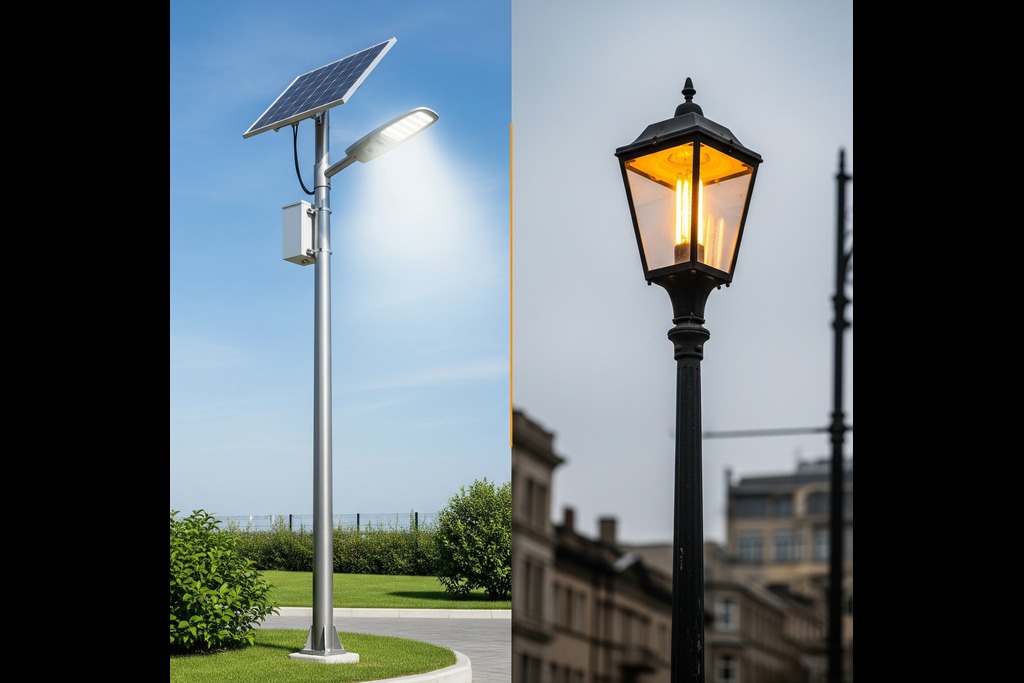Solar vs Traditional Street Lights: A Complete Comparison Guide
In urban planning, outdoor security, and public infrastructure, the use of street lighting is of paramount importance. Cities and towns globally have, over decades, depended on conventional grid-electricity-powered street lights to light roads, highways, residential neighborhoods, and public places. With increasing energy prices, carbon emissions concerns, and global efforts toward sustainability, there now exists a revolutionary substitute—solar street lights.

In this blog post, we immerse ourselves in the age-old solar street light vs traditional street light discussion to better inform you about their fundamental differences, long-term value, and the impact they have on the environment. Whether you’re a city planner, municipal engineer, businessman, or homeowner looking for an environmentally friendly lighting alternative, this in-depth comparison will give you the information you need to make the right decision.
What Are Traditional Street Lights?
Traditional lights commonly known as grid-powered or conventional street lights have a connection to the neighborhood electricity grid. Most commonly, they use high-intensity discharge lights, the most common being high pressure sodium (HPS), mercury vapor, or metal halide lamps. Such lights are very demanding to install with their elaborate underground wiring, transformers, and utility poles and these are expensive in terms of cost of installation and maintenance.
Although traditional street lights are dependable when it comes to providing constant power in these areas, they consume a lot of energy, are costly to maintain in the long run, and also result in production of greenhouse gases. As power outages and electricity costs rise, the need for more energy efficient street lights becomes increasingly evident.
What Is a Solar Street Light?
An electric grid connection is not necessary for a solar street light to function. Using photovoltaic (solar) panels, it captures solar energy, stores it in a rechargeable battery, and uses it to power LED lights at night. Without the need for trenching, wiring, or continuous electricity bills, solar street lights are self-sufficient systems.
In rural or isolated locations where grid power is erratic or nonexistent, these systems work especially well. They are smart and sustainable thanks to the integration of energy management technology and intelligent sensors.
Solar Street Light vs Traditional Street Light: A Comparative Overview
Let’s explore the key differences between solar street lights and traditional street lights in terms of cost, performance, energy efficiency, environmental impact, and maintenance:
1. Energy Source
- Traditional Street Lights: Powered by grid electricity, typically generated from fossil fuels.
- Solar Street Lights: Powered by sunlight, converted into energy by solar panels and stored in batteries.
Solar street lights are part of a sustainable solar lighting system that reduces reliance on non-renewable energy sources.
2. Installation & Infrastructure
- Traditional: Requires trenching for underground wiring, transformers, and constant connection to the electric grid.
- Solar: Standalone units with no wiring or external power connection needed.
Solar street lights are simpler and cheaper to install, especially in remote or hard-to-reach locations.
3. Maintenance & Operational Costs
- Traditional: High ongoing electricity bills, maintenance of wiring, bulbs, and fixtures.
- Solar: Minimal operational cost; occasional battery or panel replacement every 5–7 years.
Benefits of solar powered street lights include drastically lower operational and maintenance costs.
4. Performance During Power Outages
- Traditional: Dependent on grid stability; goes out during power failures.
- Solar: Fully autonomous; functions even during grid outages.
Solar street lights offer more reliable lighting during emergencies and power cuts.
5. Environmental Impact
- Traditional: High carbon footprint due to fossil-fuel-based electricity generation.
- Solar: Zero emissions, environmentally friendly, supports green initiatives.
Solar wins in the sustainability department with a significant reduction in carbon emissions.
Exploring the Types of Solar Street Lights
There are several types of solar street lights, each designed for different applications and efficiency levels:
1. Standalone Solar Street Lights
- Independent units with a solar panel, battery, and LED light.
- Ideal for remote villages, parks, and isolated roads.
2. All-in-One Solar Street Lights
- Compact design with all components integrated into one unit.
- Easy to install and maintain, with motion sensors and smart features.
3. Hybrid Solar Street Lights
- Combines solar energy with grid backup.
- Ensures lighting even during prolonged cloudy days or high usage.
4. Smart Solar Street Lights
- Equipped with IoT, sensors, and wireless control systems.
- Used in smart cities for adaptive lighting and energy optimization.
Choosing the right type depends on your lighting needs, budget, and location. Regardless of type, all options provide access to energy efficient street lights that reduce energy bills and environmental impact.
Benefits of Solar Powered Street Lights
Solar street lights offer a wide range of advantages over traditional lighting systems. Let’s explore some of the most notable benefits of solar powered street lights:
1. Cost Savings: Once installed, solar lights require no electricity bills. The initial investment pays off in the long term through savings on power and maintenance.
2. Sustainability: Solar lights operate using clean, renewable energy, helping communities reduce their carbon footprint and fight climate change.
3. Grid Independence: Perfect for rural or disaster-prone areas where grid connectivity is weak or unavailable.
4. Enhanced Safety: No wiring means fewer electrical accidents or fire hazards. Moreover, solar street lights continue to function during power outages, improving public safety.
5. Low Maintenance: High-quality components and durable designs mean fewer replacements and repairs compared to traditional systems.
6. Smart Technology Integration: Modern solar lights come with smart sensors, dimming features, and remote monitoring capabilities for better control and efficiency.
7. Aesthetic & Functional Flexibility: Available in a wide range of designs to suit urban, rural, commercial, and residential environments.
Solar Lighting System: A Future-Ready Solution
A solar lighting system is more than just a light on a pole—it’s a smart, scalable infrastructure solution that combines innovation, technology, and sustainability. Components typically include:
- Solar Panels – Capture and convert sunlight into energy.
- Rechargeable Batteries – Store energy for nighttime use.
- LED Luminaires – Offer brighter, more energy-efficient lighting.
- Controllers & Sensors – Manage charging, lighting schedules, and energy use.
This system can be customized for various applications: highways, parking lots, campuses, parks, industrial areas, and even private properties. With rising energy awareness and green building policies, solar lighting is rapidly becoming the go-to solution for outdoor illumination.
Why Energy Efficient Street Lights Matter
As urban populations increase and cities expand, the need for outdoor lighting goes on increasing. But conventional lighting mechanisms put an enormous load on national electricity grids and fossil fuel dependence. On the other hand, energy efficient street lights, particularly solar-powered lights, decrease electricity usage, minimize emissions, and enable sustainable urban expansion.
For businesses and governments, going solar is not only a green obligation but also a sound economic decision. The lower Total Cost of Ownership (TCO), along with green incentives, tax credits, and brand image, make solar street lighting a good investment.
Conclusion
In the solar street light vs traditional street light debate, solar is clearly the winner for its sustainability, cost-effectiveness, installation ease, and minimal maintenance. While traditional lights remain useful in certain situations, they are in the process of being rendered obsolete in a world trending toward energy independence and environmental responsibility.
No matter if you are illuminating a residential street or a business compound, installing a solar lighting system is a smart decision. Learn about the various solar street lights that exist nowadays and find out how you can gain from solar powered street lights that are not only brighter and more dependable but also green and economical.
Frequently Asked Questions (FAQs)
Yes. Modern solar lighting systems come with high-capacity batteries that store enough energy to power lights for multiple days, even during overcast conditions.
A well-designed solar street light can last 5–10 years or more, depending on quality and environmental factors. Batteries typically last 3–5 years and are easily replaceable.
Absolutely. Many urban municipalities are now shifting to energy efficient street lights powered by solar to reduce operational costs and meet sustainability goals.
Consider location, budget, environmental impact, maintenance needs, and long-term cost. For most areas, solar powered street lights offer a better return on investment.
Yes. Many governments and local authorities offer subsidies, grants, or tax incentives to promote the adoption of solar energy solutions.












